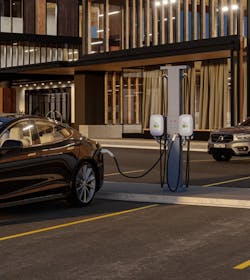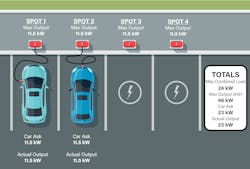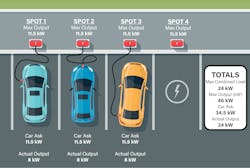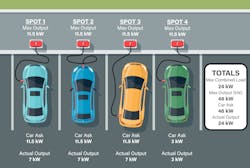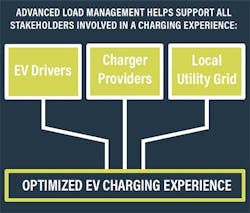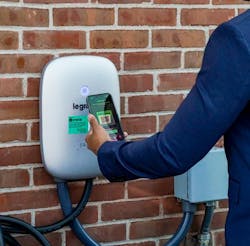“By 2040, electric vehicles will retain a significant portion of the transportation market, accounting for 54% of new car sales and 33% of the overall global fleet.”
Introduction: The EV Revolution
The world of transportation is currently in the midst of a momentous revolution, driven by a global focus on reducing carbon emissions and the widespread adoption of electric vehicles (EVs).
Several countries have made the official commitment to gradually phase out internal combustion engine vehicles and implement stringent zero-carbon emission standards for the automotive industry by 2050. Future forecasts indicate that by 2040, electric vehicles will retain a significant portion of the transportation market, accounting for 54% of new car sales and 33% of the overall global fleet. Notably, the United States has taken considerable steps in this direction by dedicating $7.5 billion through the Bipartisan Infrastructure Law to establish a robust and extensive network of public EV charging stations, a critical move to bolster the electric vehicle charging infrastructure nationwide.
How People “Refuel” Is Changing
As the international community continues to intensify its commitment to sustainability initiatives, electric vehicles are poised to become the dominant mode of transportation on the world’s roads. With governments and utility companies incentivizing the adoption of EVs and aiding in the development of critical charging infrastructure, where and how people “fuel up” is rapidly changing.
People now want to charge where they park – at home, in apartment complexes, at work and during their hotel stays. This is a shift in demand from the traditional gas depot refueling model located in between destinations to an electric top-off “refueling” model located where people park. Business owners and facility managers need to reconsider their business models and think about how to incorporate EV charging amenities into their property’s layout.
Few existing buildings and local grids were designed to support EV charging, posing additional risk to deploying widespread EV infrastructure. EV charger service providers and utilities are tasked with addressing this barrier to scalability in addition to providing the safe, reliable and convenient charging access that the growing EV driving population expects. How will a network of EV chargers impact a property’s electrical panel and local electrical grid? How can a charger provider safely and affordably scale their EV offerings to meet increasing demand?
The Challenges of EV Charger Scalability
One of the primary challenges with EV adoption is the need to support numerous vehicles charging simultaneously, especially during peak hours when demand for electricity is already high.
Some common problems EV charger owners encounter when trying to support simultaneous EV charging include:
- Increased Utility Costs: Charger owners may accrue high utility costs when multiple EVs attempt to charge at the same time, especially during peak demand hours. To accommodate the additional electrical load, local utility companies may also need to invest in extensive grid upgrades, which can be unattainably expensive and time-consuming.
- Inefficient Energy Use: Simultaneous EV charging not properly managed can lead to inefficient energy use as a site's available power capacity is not optimized.
- Grid Instability: The sudden surge of electricity demand from multiple EV chargers can overwhelm local grids, resulting in disruptions of the supply and even widespread blackouts.
Despite these challenges, a viable solution exists for commercial business owners and facility managers who want to offer semi-public or public EV charging at scale. The answer is advanced load management – a feature of intelligent EV charging solutions that makes scaling EV charging offerings affordable and safe.
This article will explore what load management is, how it works, its numerous benefits and provide key charger considerations to keep in mind when researching how to integrate EV infrastructure into existing power grids. This article will also explore the load management capabilities of the Networked Level-2 EV Charger by Legrand powered by intelligent AmpUp charging solution software.
What Is Advanced Load Management Technology?
Defining Advanced Load Management
Advanced load management technology is a smart charging solution designed to intelligently distribute and optimize the electrical load when charging electric vehicles. It ensures that the charging process is fast and convenient for EV drivers, but also cost-effective for charger providers and sustainable for the overall power grid. The technology serves as a bridge between increasing demand for EV charging and the capacity limitations of existing electrical infrastructure.
How Advanced Load Management Works
As of today, the problem with scaling EV charger infrastructure is three-fold:
- Electrical grids cannot support the full demand of every commercial EV charging station used at maximum capacity all at once.
- Individual station owners and site managers cannot afford the high cost of energy required to power each station at full capacity for each charging session on their site.
- EV drivers need to rely on charging station availability without experiencing disruptions in service due to unstable electrical flows or periodic outages.
With advanced load management, the EV charger owner can control how much power can be used at once across multiple chargers on the same commercial site. The load management software allocates power to each charger proportionately as additional vehicles begin simultaneously charging at multiple stations. The intelligent charging distribution keeps the electrical supply stable by capping each charger’s power expenditure so as not to exceed the capacity limits of the property’s electrical panel or the limitations of the local grid. The load management also assists with reducing energy consumption during the more expensive peak energy demand periods.
*Vehicles may request different amounts of power based on a variety of conditions. Vehicles may not always request the full power that is available at the charger. The load management software feature will adjust the loads based on the load limit set by the charger owner and the amount of power each vehicle is requesting.
Example Advanced Load Management Scenarios
Scenario #1 – Scaling Charger Offerings
A commercial office building needs to install 20 EV chargers for their employees to charge during the day. The building only has 400 amperes of additional power available for these chargers.
Without an advanced load management system, the building could install 20 EV chargers but would need to de-rate all 20 to have a maximum individual output of 16A -- dramatically increasing the time for every car to charge, regardless of how many cars are actively charging.
With an advanced load management system, the building could install 20 EV chargers without needing to de-rate each charger. The advanced load management system automatically changes the output of each charger depending on the cap set.
In the case of this commercial office building, advanced load management allows a property owner to install more chargers without going over their building’s power limitations or sacrificing the EV drivers’ charging experience.
Scenario #2 – Protection From Peak Usage Rates
A building owner is looking to install (20) EV chargers in their parking lot, but they are concerned that the extra power consumption may push the building over the limit allowed by the local utility and cause them to incur much more expensive peak usage electric rates.
With advanced load management, the building owner can install 20 EV chargers. The advanced load management system can cap the total output of all the chargers installed at a level that will prevent the building from entering the peak rates.
In this case, advanced load management was used to limit the combined outputs of all the chargers on one site to prevent the property owner from paying peak demand usage rates.
Benefits of Advanced Load Management Technology
Advanced load management technology presents a multitude of advantages for supporting EV charging infrastructure growth including:
- Cost Savings: Utility companies avoid adding expensive infrastructure upgrades. Charger owners do not acquire high utility costs. And EV drivers will experience more affordable charging prices.
- Fast, Convenient Charging: With energy efficiency optimized, EV drivers will enjoy a smoother charging experience with reduced wait times and faster charging.
- Robust Reliability: Prevents overloading the charging site’s electrical panel and local utility grid, resulting in consistent, reliable electricity flow and no power outages.
- Safe, Affordable Scaling: Charger owners can scale their EV offerings at a fraction of the cost without taxing their property’s electrical panel or the local utility grid.
Load Management Key Charger Considerations
NEC Codebook Guidelines
Section 625.42A of the NEC allows for an Energy Management System (EMS) to dictate the maximum equipment load permitted for installed electric vehicle chargers based on available service load.
Best Commercial Applications for Load Management
Advanced Load Management is ideal for:
Pro-TipBefore the purchase or installation of any EV charging solution, a property owner or facility manager should have a site visit with a trusted EV charger installer or manufacturer to assess the needs of the host site. During the visit, the EV expert should determine the electrical capacity of the property and discuss how the EV chargers will be used. This will determine the number of stations that can be installed and any potential infrastructure upgrade options. |
Key Charger Considerations:
|
Together We Charge: A Powerful Pair
Legrand’s Networked Level 2 EV Charger with AmpUp Charging Solution Software
Help employees, tenants & guests charge with convenience & speed through intelligent EV charging.
High-powered and versatile, Legrand’s Networked Level 2 EV charger is an ideal solution for commercial applications where advanced load management is needed most, such as commercial offices, hotels, apartment complexes and other multi-dwelling or multi-purpose spaces.
The charger is factory configured with AmpUp charging management software which simplifies installation and provides property owners and facility managers with fast, reliable remote access for control and charging data reporting of the networked charger – including load management. Charger installation and activation is as easy as turning on the unit and scanning the QR code, saving time for electrical installers and property managers.
The AmpUp charger management platform is capable of providing advanced load management at the location level. This means that at a location with load management enabled, the AmpUp server dynamically adjusts load across active charging stations towards the set maximum power output. The maximum load can be set at the click of a button using the AmpUp Community Manager user interface.
LOAD MANAGEMENT OUTPUTS:
- When a new charging session starts that would cause the load to exceed the building’s set maximum, the load of existing ongoing charging sessions is automatically adjusted down so that total power output returns to the target level.
- When a charging session ends, the load of remaining ongoing charging sessions is adjusted up automatically to utilize the freed-up load.
- When the site host manually adjusts the maximum load level (up or down), all ongoing charging sessions adjust accordingly to keep total power below the new target level.
The AmpUp charging network currently operates a dynamic, equitable load management system that allocates available power across chargers, proportional to the charger voltage capabilities. However, future load management features will include charging priority for specific vehicles – most helpful in a fleet of known commercial vehicles – and the ability to dictate charging priority based on a vehicle’s current battery State of Charge.
Note: A PRO Subscription from AmpUp is required to activate the load control functionality with installed chargers.
Managing Load Control within AmpUp Community Manager:
- Launch the AmpUp Community Manager.
- Navigate to the Locations Dashboard and select charger location.
- Select Operations.
- Move the slider on the screen to the desired load limit. Available in increments of 1kW.
- Changes are saved automatically and chargers in that location will now dynamically manage their load based on the limit set.
Ready to Charge?
At Legrand and AmpUp, we know EV charging. Partner together with us today to learn more about our networked EV charger solution that offers the load management features you want and need for your unique commercial application.
Sponsored by:

